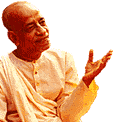Chapter 5: Karma-yoga-Action in Krsna Consciousness
Bg 5.6
TEXT 6
sannyasas tu maha-baho
duhkham aptum ayogatah
yoga-yukto munir brahma
na cirenadhigacchati
duhkham aptum ayogatah
yoga-yukto munir brahma
na cirenadhigacchati
SYNONYMS
sannyasah—the renounced order of life; tu—but; maha-baho—O mighty-armed one; duhkham—distress; aptum—to be afflicted with; ayogatah—without devotional service; yoga-yuktah—one engaged in devotional service; munih—thinker; brahma—Supreme; na—without; cirena—delay; adhigacchati—attains.
TRANSLATION
Unless one is engaged in the devotional service of the Lord, mere renunciation of activities cannot make one happy. The sages, purified by works of devotion, achieve the Supreme without delay.
PURPORT
There are two classes of sannyasis, or persons in the renounced order of life. The Mayavadi sannyasis are engaged in the study of sankhya philosophy, whereas the Vaisnava sannyasis are engaged in the study of Bhagavatam philosophy, which affords the proper commentary on the Vedanta-sutras. The Mayavadi sannyasis also study the Vedanta-sutras, but use their own commentary, called Sariraka-bhasya, written by Sankaracarya. The students of the Bhagavata school are engaged in devotional service of the Lord, according to pancaratriki regulations, and therefore the Vaisnava sannyasis have multiple engagements in the transcendental service of the Lord. The Vaisnava sannyasis have nothing to do with material activities, and yet they perform various activities in their devotional service to the Lord. But the Mayavadi sannyasis, engaged in the studies of sankhya and Vedanta and speculation, cannot relish transcendental service of the Lord. Because their studies become very tedious, they sometimes become tired of Brahman speculation, and thus they take shelter of the Bhagavatam without proper understanding. Consequently their study of the Srimad-Bhagavatam becomes troublesome. Dry speculations and impersonal interpretations by artificial means are all useless for the Mayavadi sannyasis. The Vaisnava sannyasis, who are engaged in devotional service, are happy in the discharge of their transcendental duties, and they have the guarantee of ultimate entrance into the kingdom of God. The Mayavadi sannyasis sometimes fall down from the path of self-realization and again enter into material activities of a philanthropic and altruistic nature, which are nothing but material engagements. Therefore, the conclusion is that those who are engaged in Krsna consciousness are better situated than the sannyasis engaged in simple Brahman speculation, although they too come to Krsna consciousness, after many births.
Copyright (c) 1972 by His Divine Grace A.C. Bhaktivedanta Swami Prabhupada











